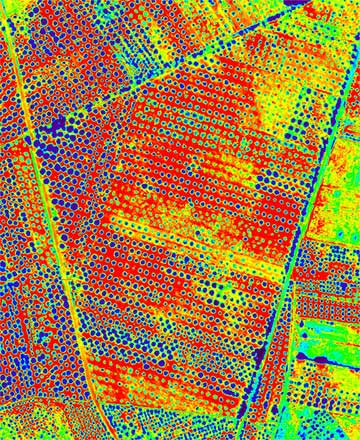
Airborne hyperspectral images acquired over the Xylella fastidiosa infected region in Puglia, Southern Italy, showing spectral bands (6 nm widths) in the blue, red and NIR regions. Affected trees are shown in lighter colors. [Image: Pablo J. Zarco-Tejada]
Xylella fastidiosa is a bacterium transmitted by common sap-feeding insects that affects more than 350 plant species, and that particularly ravages olive orchards. This plant pathogen threatens food security as well as ecosystem integrity, and is viewed as one of the most dangerous plant bacteria worldwide. Now, a European research team has devised an airborne remote-detection imaging system that’s capable of discovering infected trees, even before visible symptoms appear (Nat. Plants, doi: 10.1038/s41477-018-0189-7).
The earlier, the better
Olive trees are iconic in the Mediterranean region, and although X. fastidiosa is more common in the Americas, the pathogen has recently destroyed many orchards in the olive-oil-producing region of Apulia, Italy. Signs of infection include withered branches and scorched leaves. But by the time these symptoms appear, it is too late; the particular vulnerability of olive trees to the pathogen and the fact that there is no cure mean that early detection is essential to eradicating Xylella infection. Otherwise, there is nothing left to do but cull diseased trees.
In principle, remote-sensing techniques might help in targeting X. fastidiosa. But standard large-scale NIR mapping methods and variations obtained from broadband satellite sensors are useful only for detecting advanced disease, and hyperspectral satellite sensors lack the spatial resolution to distinguish individual tree crowns. Containment efforts require higher-spatial-resolution (submeter) imaging spectroscopy and thermal data to analyze the more subtle changes in plant functional traits that don’t necessarily show up on visual inspection.
Infection detection
To look at those pre-visual symptoms of infection, an international team led by Pablo Zarco-Tejada of the European Commission, along with experts from Swansea University, U.K. and other European institutions, turned to airborne imaging spectroscopy and thermography. Over the course of several years, the team used a combination of on-the-ground inspections and airborne imaging data of 7,000 trees in 15 olive orchards, and found that pre-visual physiological changes in functional plant traits that are caused by infection are, in fact, detectable by remote imaging.
Among the most sensitive traits to detect X. fastidiosa, the team’s work revealed, are chlorophyll degradation (NPQI), solar-induced fluorescence and temperature-based stress traits. By incorporating these traits into their remote-sensing models, the researchers could detect infected trees that did not yet show visible symptoms with 91 percent accuracy, “allowing for rapid and accurate mapping of Xylella-infected olive trees across target orchards,” according to Peter North, a coauthor on the study.
The hyperspectral sensor and thermal camera were flown 500 m above ground, acquiring imagery at 40- and 60-cm pixel resolutions, respectively. The team then used automatic object-based crown detection algorithms to find the mean temperature and hyperspectral reflectance for individual tree crowns. Reflectance changes in the blue region (particularly the 415-nm and 435-nm spectral bands used to calculate NPQI) consistently tracked early symptoms of infection.
Next steps
The team notes that flight data obtained during 2016 yielded quite a few supposed false positives after in situ evaluation by a plant pathologist. But in one-year post-flight evaluations, trees that had been thus tagged as false positives consistently developed symptoms of X. fastidiosa infection sooner than trees that both remote sensing and pathologist examination had identified as uninfected. This trend, according to the team, supports the remote-sensing model’s ability to detect infection before trees become visibly symptomatic.
According to the researchers, their physiology-focused airborne remote-sensing methods could help to prevent and manage plant disease epidemics. The team notes that by adjusting the model to detect changes in the most sensitive plant traits linked to a particular disease, this approach could be used worldwide to detect a variety of crop-threatening diseases.
In a press release, the team also advocated for increased international collaboration in tackling these issues. “The spread of plant diseases is predicted to become an increasing problem with climate change,” said Rocio Hernandez-Clemente, of the Swansea University research team. “International cooperation is essential for early detection, to control damage and prevent spread.”
